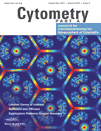
Experiment Overview
| Repository ID: | FR-FCM-ZYJR | Experiment name: | Benefits of defined mixed cultures of Geobacter sulfurreducens and Shewanella oneidensis in bioelectrochemical systems | MIFlowCyt score: | 73.75% |
| Primary researcher: | Christina Engel | PI/manager: | Florian Schattenberg | Uploaded by: | Christina Engel |
| Experiment dates: | 2017-06-12 - | Dataset uploaded: | May 2018 | Last updated: | Jul 2018 |
| Keywords: | [flow cytometry] [Bioelectrochemical systems] [biofilm] [biofilm thickness] [Geobacter sulfurreducens] [microbial electrolysis cells] [mixed culture] [planktonic] [pure culture] [Shewanella oneidensis] | Manuscripts: | [30972336] [PMC6445848] | ||
| Organizations: |
Helmholtz-Centre for Environmental Research - UFZ, Env. microbiology, Leipzig, (Germany)
|
||||
| Purpose: | This work aims to investigate the interactions of electrochemically active bacteria in bioelectrochemical systems (BESs). The electrochemical performance and biofilm characteristics of pure cultures of Geobacter sulfurreducens and Shewanella oneidensis are being compared to a defined mixed culture of both organisms. While S. oneidensis pure cultures did not form cohesive and stable biofilms on graphite anodes and only yielded 0.034 ± 0.011 mA/cm2 as maximum current density by feeding of each 5 mM lactate and acetate, G. sulfurreducens pure cultures formed 100 µm thick, area-wide biofilms with 10 mM acetate as initial substrate concentration and yielded a current of 0.39 ± 0.09 mA/cm2. Compared to the latter, a defined mixed culture of both species was able to yield 43 % higher maximum current densities of 0.56 ± 0.07 mA/cm² with each 5 mM lactate and acetate. This increase in current density was associated with a likewise increased thickness of the anodic biofilm. Using flow cytometry, it was further investigated whether S. oneidensis was incorporated into the mixed culture biofilm. | ||||
| Conclusion: | None | ||||
| Comments: | None | ||||
| Funding: | NTH-Research Unit ElektroBak - Innovative materials and concepts for microbial electrochemical systems within the Braunschweig Integrated Centre of Systems Biology (BRICS) at the Technischeheh Universität Braunschweig, Germany | ||||
| Quality control: | Cytometers were calibrated daily in the linear range with 1 μm beads (FluoSpheres F8815 (350/440), lot no.: 69A1-1) and 2 μm beads (FluoSpheres F-8827 (505/515), lot no.: 1717426), both from Molecular Probes (Eugene, Oregon, USA) and in the logarithmic range with 0.5 μm and 1 μm beads (both Fluoresbrite BB (360/407), lot no.: 552744 and 499344, PolyScience, Niles, Illinois, USA) and 0.5 and 1 µm beads were also added to each sample. A biological standard was used as a staining control. | ||||
